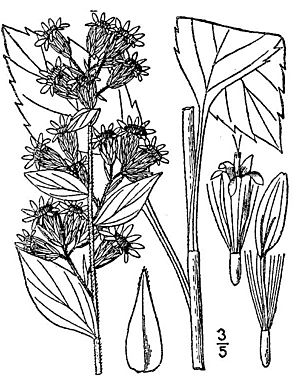Largeleaf goldenrod facts for kids
Quick facts for kids Largeleaf goldenrod |
|
|---|---|
 |
|
| 1913 illustration | |
| Scientific classification | |
| Genus: |
Solidago
|
| Species: |
macrophylla
|
| Synonyms | |
|
|
The Largeleaf Goldenrod, also known as Solidago macrophylla, is a type of plant found in North America. It is a herbaceous perennial plant, which means it has soft stems and lives for more than two years. This plant belongs to the sunflower family, just like sunflowers and daisies!
About the Largeleaf Goldenrod
The Largeleaf Goldenrod gets its name from its big leaves and its bright yellow flowers. It's a beautiful plant that adds a splash of color to many natural areas.
Where Does It Grow?
This goldenrod is native to parts of Canada and the northeastern United States. In Canada, you can find it from Ontario all the way to Newfoundland and Labrador. In the United States, it grows in New York and the New England states.
Some of these plants even grow very far north, above the Arctic Circle! This shows how tough and adaptable the Largeleaf Goldenrod can be.
What Does It Look Like?
The Largeleaf Goldenrod is a tall plant, growing up to about 105 centimeters (42 inches) high. That's more than a meter tall! It has a thick, woody part underground called a rhizome, which helps it store energy and spread.
Its leaves can be quite large, up to 15 centimeters (6 inches) long. When it blooms, one plant can produce many small, yellow flower heads. These flower heads often grow on short branches coming off the main stem, making the plant look full and bushy.

